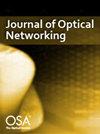Bidirectional reconfigurable optical add-drop multiplexer with power compensation built-in optical amplifiers
引用次数: 12
Abstract
A power-compensated bidirectional reconfigurable optical add-drop multiplexer (Bi-ROADM) based on tunable fiber Bragg gratings is proposed and demonstrated. By splicing a fiber Bragg grating (FBG) within a piece of an erbium-doped fiber, a lossless, low-cost, and simply structured Bi-ROADM is obtained. The total pumping power is 40mW with 0.6m of gain fiber for both upstream and downstream signals. The Bi-ROADM performance is evaluated using a bidirectional four-channel 50km lightwave transmission link using a 2.5Gbits/s bit rate per channel. Bit-error-rate (BER) performances show that the power penalties are 0.49 and 0.76dB at a 10−9 BER, respectively, for the 25km dropped channel and the 50km passed-through channel as compared to the back-to-back condition. An extra power penalty of only 0.2dB is observed for bidirectional transmission compared to the unidirectional transmission case. Cross-talk issues and chromatic dispersion are also studied. The induced power penalty by adjacent channel cross talk is negligible (≦0.2dB) with a narrow channel spacing of 1.0nm. The induced power penalty by intraband (homodyne) cross talk is also negligible for the cross-talk level of −30dB, corresponding to 99.9% reflectivity of the FBG. The Bi-ROADM may find important applications in bidirectional WDM networks and/or bidirectional transmission.带有功率补偿内置光放大器的双向可重构光加降多路复用器
提出并演示了一种基于可调谐光纤布拉格光栅的功率补偿双向可重构光加丢复用器。通过在掺铒光纤中拼接光纤布拉格光栅(FBG),获得了一种无损、低成本、结构简单的Bi-ROADM。总抽运功率为40mW,上下游信号增益为0.6m。Bi-ROADM性能通过双向四通道50km光波传输链路进行评估,每个通道的比特率为2.5Gbits/s。误码率(BER)性能表明,与背靠背条件相比,25km下降信道和50km通过信道在10 - 9误码率下的功率损失分别为0.49和0.76dB。与单向传输相比,双向传输的额外功率损失仅为0.2dB。串音问题和色散也进行了研究。相邻通道串扰的诱导功率损失可忽略不计(≦0.2dB),通道间距仅为1.0nm。当串扰水平为- 30dB时,带内(同差)串扰引起的功率惩罚也可以忽略不计,对应于光纤光栅的99.9%反射率。双向roadm在双向WDM网络和/或双向传输中有重要的应用。
本文章由计算机程序翻译,如有差异,请以英文原文为准。
求助全文
约1分钟内获得全文
求助全文

 求助内容:
求助内容: 应助结果提醒方式:
应助结果提醒方式:


